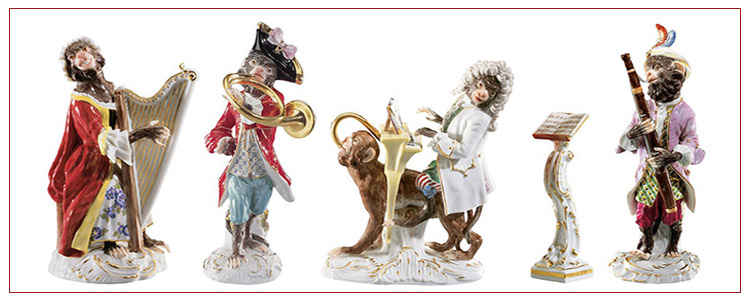«Monkey Orchestra»
Year of creation: 1750s
Sculptor: Johann Joachim Kaendler (1706-1775)
Number of figurines: 22
Height: between 12 and 15 cm
Remember the tale by Ivan Krylov, whose main aim was to expose the vices of Russian society of his time. Meissen’s collection of the “Monkey Orchestra" is based on a similar idea. There are two versions of the idea of creating this gorgeous collection, which has been famous for 300 years.

According to the first one, Johann Joachim Kaendler was invited to a gala dinner by the Elector of Saxony and Polish King Augustus III. At this dinner, the musicians of the orchestra of Count Brühl tried to create a special atmosphere for the guests but played completely out of tune. The “Monkey Orchestra” became some kind of incarnation of the caricature of court life in the 18th century and were especially a satire on the short-sighted people who happened to work at the court. The monkey symbolizes an ‘empty’ human, because he does not become a human by putting on human clothes, as was said during those times.
According to the second version, Johann Joachim Kandler was inspired to create his "Monkey Orchestra" after he heard the story of a trainer, who, after great difficulty, presented to his audience an orchestra of monkeys, who were all trained use human gestures, played musical instruments, and were dressed in coats and shoes which were high fashion that time. But the lie was revealed as the "artists" showed who they really were.
Initially the collection consisted of 19 figures. One of the first owners of these funny shapes became the Marquis de Pompadour, who bought them in 1753. Later also Catherine II (the Great) and Carl Fabergé acquired the "Monkey Orchestra". In 1765 the artist Peter Reinecke added two more figurines to the collection. Finally, in 2006, in honor of the 300th anniversary of Johann Joachim Kaendler, 300 copies were made of a 22nd figure, the "Monkey with a tambourine” (Tambour de Basque) produced.
The "Monkey Orchestra" is a collection of amusing monkey-musician figures, dressed in the fashion of the time in the Rococo style, playing various instruments and singing under the baton. Male figures are depicted as musicians and women as singers. The grotesque character of the figures is emphasized by the trendy jackets, shoes, lace, panties, grimaces and poses of the "musicians." The realistic poses, the dynamics of movement, the design of the smallest detail in the costumes and images that seem to enliven musicians are all characteristic features of these figures.
The "Monkey Orchestra" collection represents a unique value among collectors and connoisseurs of china throughout the 300-year history of the Meissen porcelain manufactory.
Buy the figurines from the collection of the "Monkey Orchestra" here
